《Spring in action 4》(三)高级装配
高级装配
莫道君行早,更有早行人
环境与Profile
在实际开发过程中,往往会将项目发布到不同的环境中,由于环境的不同,我们一般需要对在不同环境的数据和配置进行一些个性化的设定。比如,我们一般将开发到生产流程中的环境分为三种:开发(dev)、测试(test)和生产(prod)。而在这三种环境下,我们有些配置(如数据源)需要根据环境来切换。下面看看Spring中如何进行环境的个性化配置。
JavaConfig配置类
定义一个普通的User类:
public class User implements Serializable {
private String name;
private Integer age;
private String sex;
public User() {}
public User(String name, Integer age, String sex) {
this.name = name;
this.age = age;
this.sex = sex;
}
public String getName() {
return name;
}
public void setName(String name) {
this.name = name;
}
public Integer getAge() {
return age;
}
public void setAge(Integer age) {
this.age = age;
}
public String getSex() {
return sex;
}
public void setSex(String sex) {
this.sex = sex;
}
@Override
public String toString() {
return "User{" +
"name='" + name + '\'' +
", age=" + age +
", sex='" + sex + '\'' +
'}';
}
}
BeanConfigA类:(使用@Profile 来指定环境,可以修饰在类上和方法上。此处只演示修饰在类上的,表示当前类中所有的Bean都只能在dev环境下,才能实例化到IoC容器中。当修饰在方法上,与@Bean配合使用时,将用更加细粒度的控制某一个类在某种环境下才能创建出来)
@Profile(value = "dev")
@Configuration
public class BeanConfigA {
@Bean
public User user(){
return new User("张三",23,"男");
}
}
BeanConfigB类:
@Profile(value = "prod")
@Configuration
public class BeanConfigB {
@Bean
public User user(){
return new User("李四",23,"男");
}
}
BeanConfig类:
@ComponentScan(basePackages = "com.ooyhao.spring")
public class BeanConfig {}
测试类:
@RunWith(SpringJUnit4ClassRunner.class)
@ContextConfiguration(classes = BeanConfig.class)
@ActiveProfiles(value = {"prod"})
public class BeanConfigTest {
@Autowired
private User user;
@Test
public void testProfile(){
System.out.println(user);
}
}
上面使用了在集成测试类上,适应@ActiveProfiles 注解来指定当前测试的环境。
Xml配置文件的方式
beanXmlConfig.xml文件:
<?xml version="1.0" encoding="UTF-8"?>
<beans xmlns="http://www.springframework.org/schema/beans"
xmlns:xsi="http://www.w3.org/2001/XMLSchema-instance"
xsi:schemaLocation="http://www.springframework.org/schema/beans http://www.springframework.org/schema/beans/spring-beans.xsd">
<beans profile="dev">
<bean class="com.ooyhao.spring.bean.User">
<property name="name" value="ouYanghao"/>
<property name="age" value="23"/>
<property name="sex" value="男"/>
</bean>
</beans>
<beans profile="prod">
<bean class="com.ooyhao.spring.bean.User">
<property name="name" value="王五"/>
<property name="age" value="30"/>
<property name="sex" value="女"/>
</bean>
</beans>
<beans profile="test">
<bean class="com.ooyhao.spring.bean.User">
<constructor-arg name="name" value="翠花"/>
<constructor-arg name="age" value="28"/>
<constructor-arg name="sex" value="女"/>
</bean>
</beans>
</beans>
注意:
xml配置的方式可以看出:通过使用<beans> 标签中嵌套 <beans> 标签,并且使用 <beans> 标签的profile属性来指定环境。
激活Profile环境的几种方式
Spring在确定哪个Profile处于激活状态时,需要依赖两个独立的属性:spring.profiles.active 和 spring.profiles.default . 如果设置了spring.profiles.active 属性的话,那么它的值就会用来确定哪个profile是激活的。但是如果没有设置spring.profiles.active的话,那spring将会查找 spring.profiles.default 的值,如果spring.profiles.default 和 spring.profiles.active 的值均没设定时,那么久无法激活profile,只有那些没有定义在任何profile中的Bean才会会创建。
有多种方式来设定这两个属性:
- 作为DispatcherServlet的初始化参数;
- 作为Web应用的上下文参数;
- 作为JNDI条目;
- 作为环境变量;
- 作为JVM的系统属性;
- 在集成测试类上,使用
@ActiveProfiles注解设置。
在Web.xml文件中设置:
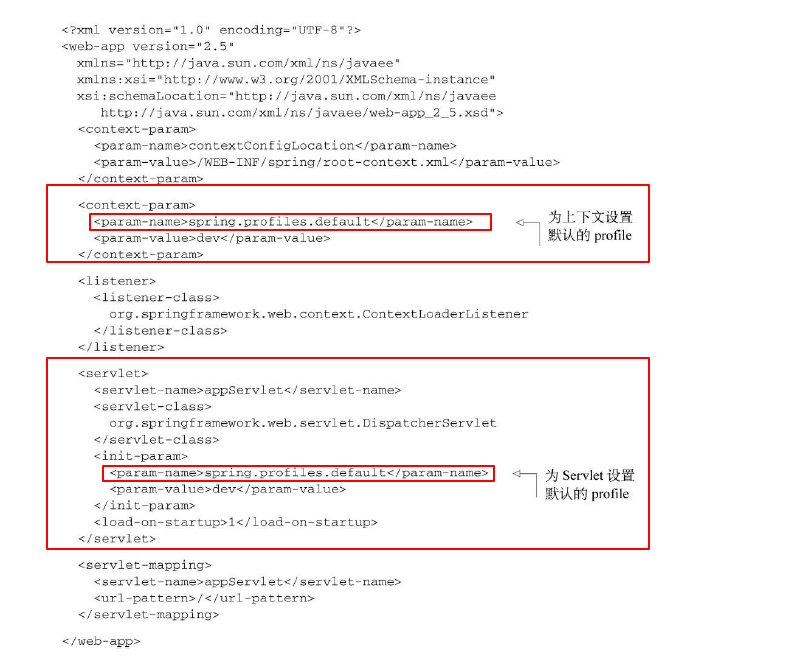
Idea 中如何修改环境变量:
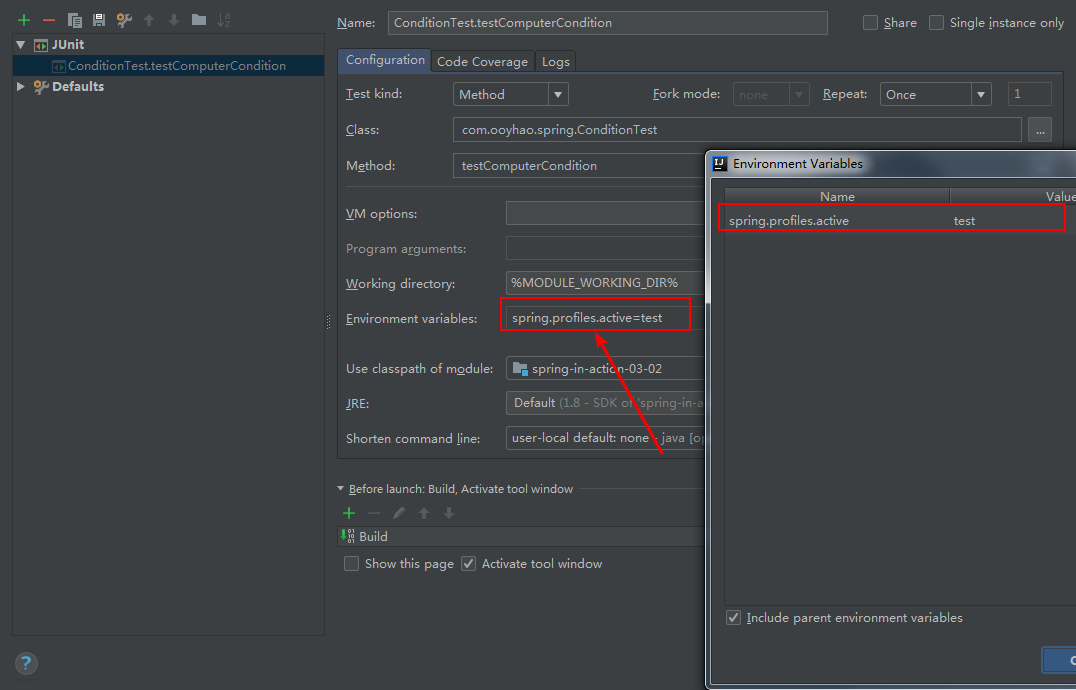
Idea 中如何修改JVM的系统变量:
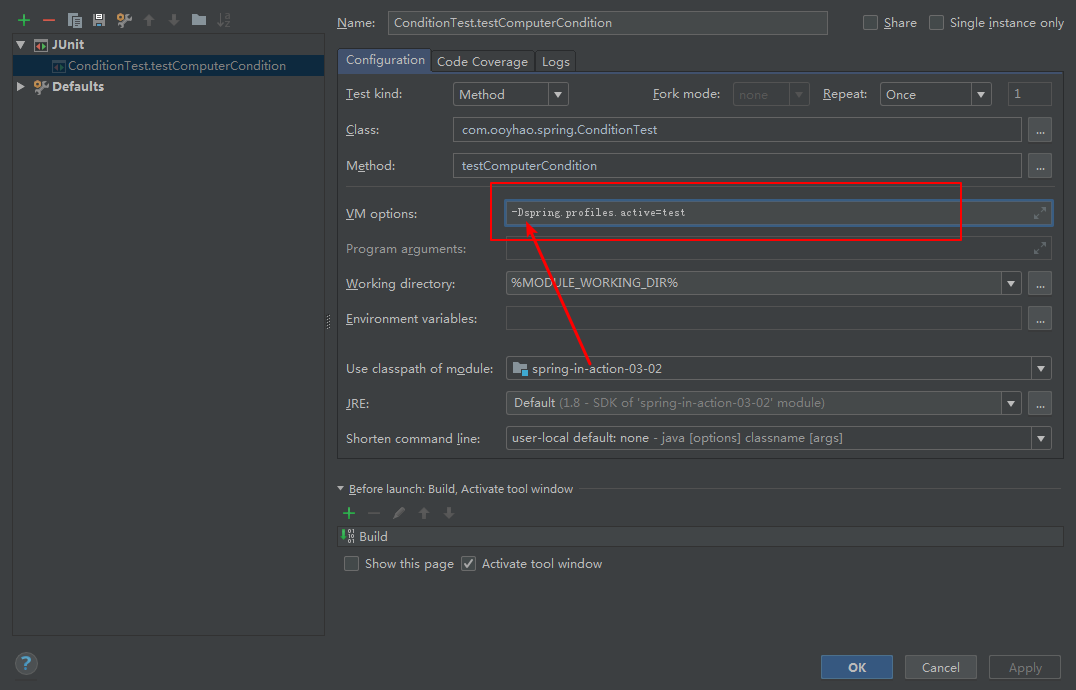
在集成测试类上 ,使用@ActiveProfiles注解设置。
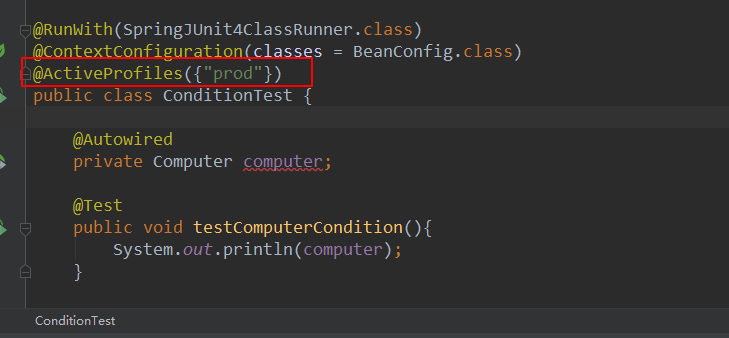
条件化的Bean
基本使用
在实际开发中,有时候需要控制某些Bean在某些特定的时候才创建,在Spring4之前很难实现这种条件化配置,但是spring4中引入了@Conditional 注解,他可以用到带有@Bean 注解的方法上,如果给定的条件计算结果为true,就会创建这个Bean,否则就会忽略这个Bean的创建。
下面我们以笔记本电脑和笔记本电池为案例,展开讲述 @Conditional 的使用,设定:笔记本创建时需要判断笔记本电池是否创建?
案例:当我们创建Computer类时,假设需要依赖于Battery类,如果当前容器中没有创建Battery实例,Computer就不创建了。
Computer 类:
public class Computer {
private String brand;
private String name;
private Battery battery;
//noArgsConstructor
//allArgsConstructor
//getter and setter
//toString
}
Battery 类:
public class Battery {
private String brand;
private String name;
//noArgsContructor
//allArgsConstrctor
//getter and setter
//toString
}
ComputerCondition类:
通过使自定义Condition类实现Spring的Condition接口,并实现matches方法,依照其返回值true和false来判断标有@Conditional(ComputerCondition.class) 的bean是否创建。
public class ComputerCondition implements Condition {
/*判断是否某个Bean存在时,存创建指定的Bean*/
public boolean matches(ConditionContext context, AnnotatedTypeMetadata metadata) {
try {
ConfigurableListableBeanFactory factory = context.getBeanFactory();
Battery bean = factory.getBean(Battery.class);
System.out.println(bean);
if (bean == null) {
return false;
}
return true;
}catch (Exception e){
return false;
}
}
}
配置类:
public class BeanConfig {
//@Bean
public Battery battery(){
return new Battery("小米","小米笔记本电池");
}
@Bean
@Conditional(ComputerCondition.class)
public Computer computer(Battery battery){
Computer computer = new Computer();
computer.setBrand("小米");
computer.setName("小米笔记本");
computer.setBattery(battery);
return computer;
}
}
测试,将创建容器后用断点截断,查看:
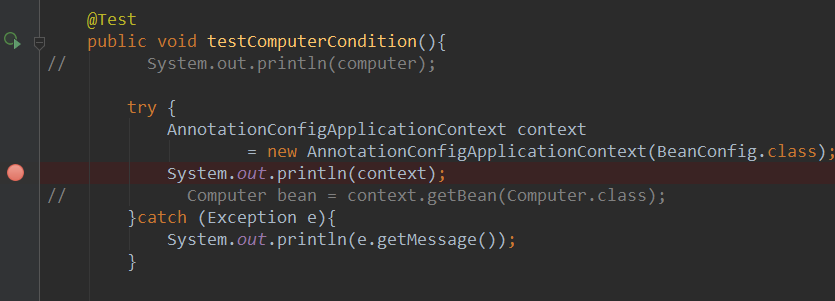
测试结果可以直接查看Spring IoC容器中创建了哪些Bean。下图中的 BeanDefinitionMap 就是IoC容器存放Bean的一个地方。
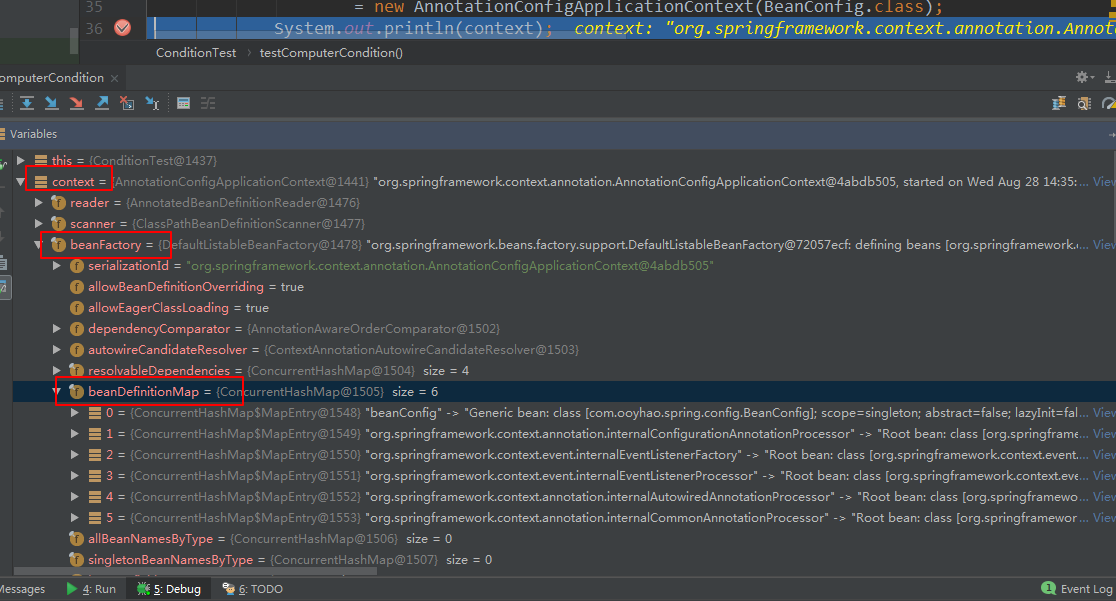
而将配置类中创建电池方法的@Bean 注解注释取消之后,其结果如下图:

小案例
用@Conditional 注解来实现@profiles 功能,并且要求在不同的环境下 ,创建不同的Computer Bean。
DevCondition:
public class DevCondition implements Condition {
public boolean matches(ConditionContext context, AnnotatedTypeMetadata metadata) {
return context.getEnvironment().acceptsProfiles(new Profiles() {
@Override
public boolean matches(Predicate<String> activeProfiles) {
return activeProfiles.test("dev");//
}
});
}
}
TestCondition和ProdCondition只需要将上述代码中的dev改成test或是prod即可。
自定义注解,通过使用@Conditional 注解来标注,即相当于继承了@Conditional 注解,通过制定DevCondition.class. 表示当前注解条件判断是使用DevCondition中的逻辑来判断的。
@Target({ElementType.METHOD,ElementType.TYPE})
@Inherited
@Retention(RetentionPolicy.RUNTIME)
@Conditional(DevCondition.class)
public @interface DevConditional {}
@TestConditional 和 @ProdConditional 只需要修改其传入@Conditional 注解的类即可。
配置类:
public class BeanConfig {
@Bean
public Battery battery(){
return new Battery("小米","小米笔记本电池");
}
@Bean
@DevConditional
public Computer devComputer(){
Computer computer = new Computer();
computer.setBrand("小米");
computer.setName("小米笔记本-DEV");
computer.setBattery(battery());
return computer;
}
@Bean
@TestConditional
public Computer testComputer(){
Computer computer = new Computer();
computer.setBrand("小米");
computer.setName("小米笔记本-TEST");
computer.setBattery(battery());
return computer;
}
@Bean
@ProdConditional
public Computer prodComputer(){
Computer computer = new Computer();
computer.setBrand("小米");
computer.setName("小米笔记本-PROD");
computer.setBattery(battery());
return computer;
}
}
测试:通过前面的几种方式可以切换环境,可以测试出能够根据环境的不同产生不同的Computer。
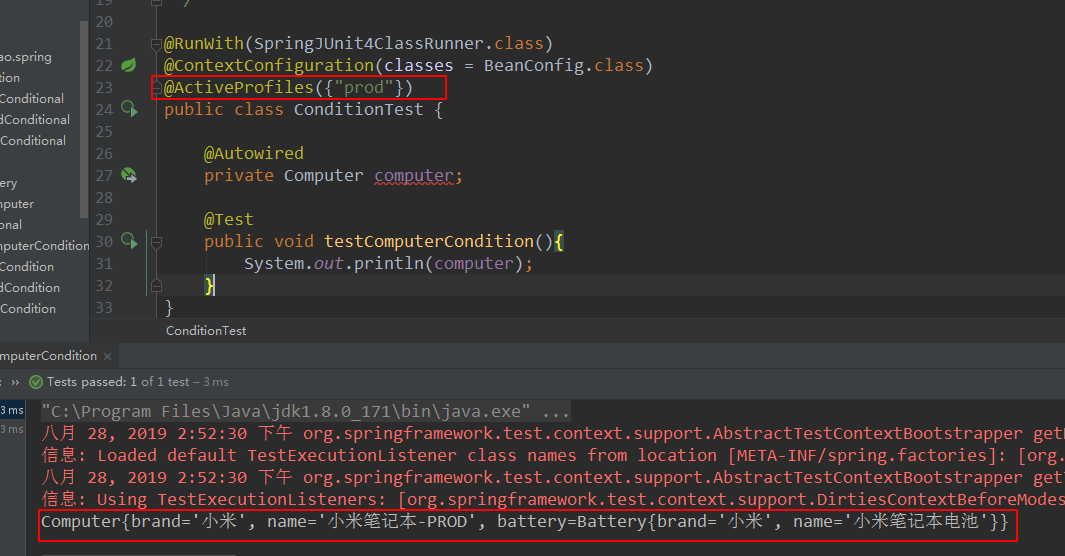
matches方法
上面案例和介绍可以看出,通过@Conditional 以及配合Condition接口来实现工作是很简单的,实现Condition接口只需要实现matches方法即可,接下来我们来详细看一下matches方法传入的两个参数:ConditionContext和AnnotatedTypeMetaData。
ConditionContext
ConditionContext是一个接口,源代码如下:
// @since 4.0
public interface ConditionContext {
BeanDefinitionRegistry getRegistry();
@Nullable
ConfigurableListableBeanFactory getBeanFactory();
Environment getEnvironment();
ResourceLoader getResourceLoader();
@Nullable
ClassLoader getClassLoader();
}
通过ConditionContext,我们可以做到如下几点:
- 借助getRegistry()返回的BeanDefinitionRegistry检查bean定义;
- 借助getBeanFactory()返回的ConfigurableListableBeanFactory检查bean是否存在甚至探查bean的属性;
- 借助getEnvironment()返回的Environment检查环境变量是否存在以及它的值是什么;
- 读取并探查getResourceLoader()返回的ResourceLoader所加载的资源;
- 借助getClassLoader()返回的ClassLoader加载并检查类是否存在;
AnnotatedTypeMetaData
AnnotatedTypeMetaData则能够让我们检查带有@Bean 注解的方法上还有什么 注解。与ConditionContext一样,也是一个接口:
// @since 4.0
public interface AnnotatedTypeMetadata {
boolean isAnnotated(String annotationName);
@Nullable
Map<String, Object> getAnnotationAttributes(String annotationName);
@Nullable
Map<String, Object> getAnnotationAttributes(String annotationName, boolean classValuesAsString);
@Nullable
MultiValueMap<String, Object> getAllAnnotationAttributes(String annotationName);
@Nullable
MultiValueMap<String, Object> getAllAnnotationAttributes(String annotationName, boolean classValuesAsString);
}
借助isAnntated()方法,我们能够判断带有@Bean 注解的方法是不是还有其他特定的注解。借助其他的那些方法,我们能够检查@Bean 注解的方法是不是还有其他注解。
其实@Profiles 注解也是使用了@Conditional 注解,并且引用ProfileCondition作为Condition实现,如下所示,ProfileCondition实现了Condition接口,并且在作出决策的过程中,考虑到了ConditionContext 和 AnnotatedTypeMetaData中的多个元素。
class ProfileCondition implements Condition {
@Override
public boolean matches(ConditionContext context, AnnotatedTypeMetadata metadata) {
MultiValueMap<String, Object> attrs = metadata.getAllAnnotationAttributes(Profile.class.getName());
if (attrs != null) {
for (Object value : attrs.get("value")) {
if (context.getEnvironment().acceptsProfiles(Profiles.of((String[]) value))) {
return true;
}
}
return false;
}
return true;
}
}
处理歧义性Bean
当我们在注入Bean的时候,不管是byType,还是byName,如果遇到了两个相同的Bean的时候,Spring就会包NoUniqueBeanDefinitionException 即:不唯一的Bean的定义异常。
Animal:
public interface Animal {}
Cat:(省略无参构造,全参构造,getter,setter,toString方法,后面亦如此)
public class Cat implements Animal {
private String name;
private Integer age;
}
Dog:
public class Dog implements Animal {
private String name;
private Integer age;
}
Person:
public class Person {
private String name;
private Animal pet;
}
BeanConfig:
public class BeanConfig {
@Bean
public Animal cat(){
return new Cat("小喵",3);
}
@Bean
public Animal dog(){
return new Dog("小七",2);
}
/**
* 实例化一个类,其宠物是Animal类型
* */
@Bean
public Person person(Animal animal){
return new Person("张三",animal);
}
}
上述代码运行如下(报错:Bean定义不唯一异常,需要装配Animal,希望找到一个,但是发现了两个,cat,dog):

标注首选项
JavaConfig配置类形式
public class BeanConfig {
@Bean
@Primary
public Animal cat(){
return new Cat("小喵",3);
}
@Bean
public Animal dog(){
return new Dog("小七",2);
}
/**
* 实例化一个类,其宠物是Animal类型
* */
@Bean
public Person person(Animal animal){
return new Person("张三",animal);
}
}
XML配置形式
multiBean.xml:
<?xml version="1.0" encoding="UTF-8"?>
<beans xmlns="http://www.springframework.org/schema/beans"
xmlns:xsi="http://www.w3.org/2001/XMLSchema-instance"
xsi:schemaLocation="http://www.springframework.org/schema/beans
http://www.springframework.org/schema/beans/spring-beans.xsd">
<bean class="com.ooyhao.spring.bean.Dog" primary="true" >
<property name="name" value="小小七"/>
<property name="age" value="1"/>
</bean>
<bean class="com.ooyhao.spring.bean.Cat">
<property name="name" value="小小喵"/>
<property name="age" value="1"/>
</bean>
</beans>
XmlBeanConfig配置类:
@ImportResource("classpath:multiBean.xml")
public class XmlBeanConfig {
@Bean
public Person person(Animal animal){
return new Person("王五",animal);
}
}
总结:
通过上述JavaConfig配置类或是Xml配置文件,可以发现,其实在遇到歧义性Bean的时候,可以通过标注首选项来解决,在JavaConfig配置类上使用@Primary 注解 或是在 Xml配置文件在bean标签中使用primary=true 来实现。
限制自动装配的Bean
如果在实际项目中byType注入的时候出现多个相同的Bean的时候,我们可以通过ID的形式注入。如下:
在Cat和Dog类上使用@Component 注解标注,Person类如下:
@Component
public class Person {
private String name;
// @Autowired
// @Qualifier("dog")
@Resource(name = "dog")
private Animal pet;
}
通过使用@Autowired 和 @Qualifier 配合使用,并在Qualifier中指定Bean的ID。或者使用@Resource注解,在其name属性指定bean 的Id。
这里特别注释一下这几个注解的注入方式:
- @AutoWired 注解
默认是byType 进行装配的,如果在IoC容器中存在两个或两个以上的Bean类型一致时,Autowired会转变为byName进行装配,如果此时相同类型的Bean的ID存在0个或两个以两个以上与需要注入属性的名字一致,则会抛出 NoUniqueBeanDefinitionException 异常。如果此时需要装配Bean的ID与属性名不一致,可以配合@Qualifier 注解来标注。
- @Resource 注解
@Resource其实与@Autowired的作用是一致的,都是用来装配Bean的,但是@Resource默认是byName来装配的,@Resource有两个比较 重要的属性,一个是name,一个是type,如果指定name,其实就是使用byName进行装配,如果指定type,则是使用byType进行装配。
装配顺序如下:
- 如果同时指定了name和type,则从Spring上下文中找到唯一匹配的bean进行装配,找不到则抛出异常。
- 如果指定了name,则从上下文中查找名称(id)匹配的Bean进行装配,否则就抛出异常。
- 如果指定了type,则从上下文中查找类型匹配的唯一bean进行装配,找不到或者多个,都会抛出异常。
- 如果既没有指定name,又没有指定type,则自动按照byName方式进行装配;如果没有匹配,则回退为类型匹配,如果匹配则自动装配。
-
@Qualifier注解
不仅可以与Autowired注解配置使用标注在属性,构造方法,set方法上,还可以标注在类上,如果一个类使用@Component注解标注,通过自动扫描产生的Bean的ID是类名的首字母小写的形式,而如果使用@Qualifier注解组合标注,只需要在注入的时候,选择合适的标注信息进行标注即可。
注意:
1和2 示例中,使用@Qualifier注解只是为Dog对象打一个标注,并不是将Dog对象的ID由dog变成了pet,所以,如果在注入的时候,仅是使用2中的代码依旧会抛出异常,需要使用3中的代码,即需要在注入的时候加上这个标注。如果需要使用2中的代码,则需要将Dog的ID由dog修改为pet,即直接在@Component的value中指定为pet即可。
// ----------------------1------------------------------
@Component
@Qualifier("pet")
public class Dog implements Animal {
private String name;
private Integer age;
}
// ----------------------2-------------------------------
@Component
public class Person {
private String name;
@Autowired
private Animal pet;
}
// ----------------------3-------------------------------
@Component
public class Person {
private String name;
@Autowired
@Qualifier("pet")
private Animal pet;
}
//------------------------4-----------------------------
@Component("pet")
//@Qualifier("pet")
public class Dog implements Animal {
private String name;
private Integer age;
}
由于@Qualifier的注解只是将Bean打上一个标注,而如果遇到两个或两个以上的Bean打了一个相同的标注,此时又无法实现装配了,有人可能会说,一个不够,那就多打几个。由图片可以看出,不支持标注多个@Qualifier的注解,否则会报编译异常。那么如何解决呢?
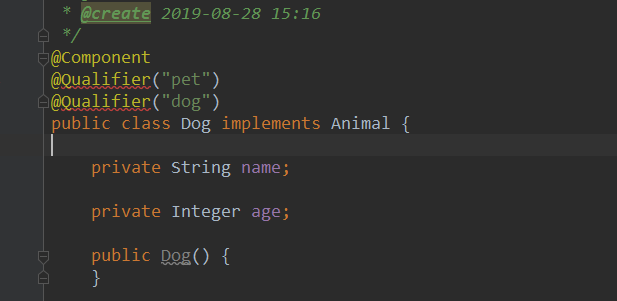
上述问题可以通过自定义注解来解决,自定义注解结合@Qualifier注解实现,如下:
IPet注解:
@Target({ElementType.METHOD,ElementType.TYPE,ElementType.FIELD})
@Retention(RetentionPolicy.RUNTIME)
@Qualifier
public @interface IPet {}
ICat注解:
@Target({ElementType.METHOD,ElementType.TYPE,ElementType.FIELD})
@Retention(RetentionPolicy.RUNTIME)
@Qualifier
public @interface ICat {}
IDog注解:
@Target({ElementType.METHOD,ElementType.TYPE,ElementType.FIELD})
@Retention(RetentionPolicy.RUNTIME)
@Qualifier
public @interface IDog {}
Cat类:
@Component
@IPet
@ICat
public class Cat implements Animal {
private String name;
private Integer age;
}
Dog类:
@Component
@IPet
@IDog
public class Dog implements Animal {
private String name;
private Integer age;
}
Person类使用:
@Component
public class Person {
private String name;
@Autowired
@IPet
@IDog
private Animal pet;
}
测试结果如下:
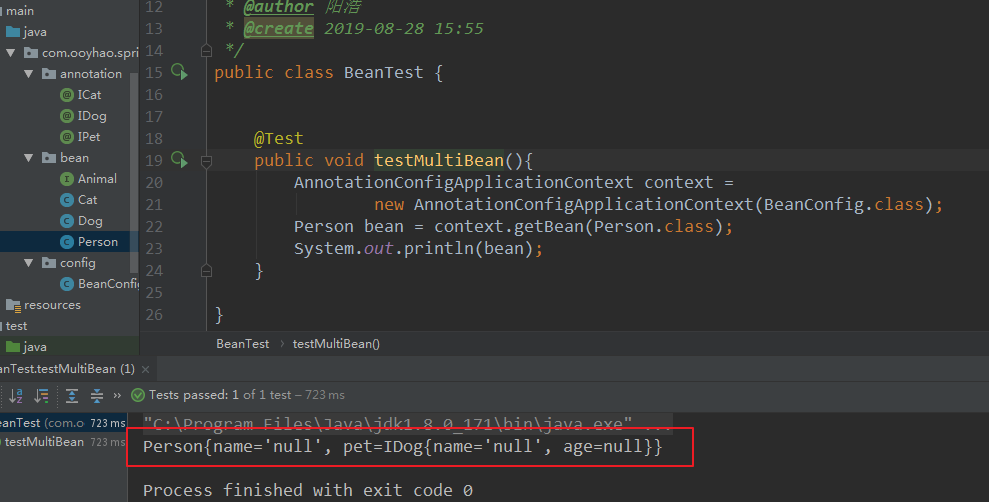
Bean的作用域
Bean的作用域分为四种:singleton, prototype, session, request.
- singleton:单例,默认,即每次从容器中获取的对象都是同一个
- prototype:多例(原型),即每次从容器中获取的对象都是不一样的。
- session:回话,用于web环境,一次session回话是同一个对象。
- request:请求,用于web环境,一次request请求是同一个对象。
常见的作用域是singleton和prototype,下面主要是演示下面两种:
Java配置类形式
singleton作用域:
@Component
@Scope(ConfigurableBeanFactory.SCOPE_SINGLETON)
public class Cat implements Animal {
private String name;
private Integer age;
}
prototype作用域:
@Component
@Scope(ConfigurableBeanFactory.SCOPE_PROTOTYPE)
public class Dog implements Animal {
private String name;
private Integer age;
}
BeanConfig 配置类:
@ComponentScan(basePackages = "com.ooyhao.spring")
public class BeanConfig {}
测试类:
public class ScopeTest {
@Test
public void testScope(){
AnnotationConfigApplicationContext context
= new AnnotationConfigApplicationContext(BeanConfig.class);
Cat bean1 = context.getBean(Cat.class);
Cat bean2 = context.getBean(Cat.class);
System.out.println(bean1 == bean2);//true
Dog dog1 = context.getBean(Dog.class);
Dog dog2 = context.getBean(Dog.class);
System.out.println(dog1 == dog2);//false
}
}
Xml配置文件形式
Bean类:
public class Computer {}
public class MobilePhone {}
scope.xml配置文件:
<?xml version="1.0" encoding="UTF-8"?>
<beans xmlns="http://www.springframework.org/schema/beans"
xmlns:xsi="http://www.w3.org/2001/XMLSchema-instance"
xsi:schemaLocation="http://www.springframework.org/schema/beans
http://www.springframework.org/schema/beans/spring-beans.xsd">
<bean class="com.ooyhao.spring.bean.Computer" scope="singleton"/>
<bean class="com.ooyhao.spring.bean.MobilePhone" scope="prototype"/>
</beans>
测试类:
@Test
public void testXmlConfig(){
ClassPathXmlApplicationContext context
= new ClassPathXmlApplicationContext("scope.xml");
Computer computer1 = context.getBean(Computer.class);
Computer computer2 = context.getBean(Computer.class);
System.out.println(computer1 == computer2);//true
MobilePhone mobilePhone1 = context.getBean(MobilePhone.class);
MobilePhone mobilePhone2 = context.getBean(MobilePhone.class);
System.out.println(mobilePhone1 == mobilePhone2);//false
}
运行时注入值
Spring 提供了两种在运行时求的方式:
- 属性占位符(${})
- Spring表达式语言(#{})
注入外部值
在Spring中,处理外部值的最简单方式就是声明属性源并通过Spring的Environment来检索属性。
application.properties文件:
name=ooyhao
age=12
sex=男
通过使用@PropertySource注解,将指定下的文件(此例:application.properties)会被加载到Spring的Environment中,稍后可以从这里检索属性。
UserConfig配置文件:
@PropertySources(
@PropertySource(value = "classpath:application.properties",encoding = "utf-8")
)
public class UserConfig {
@Autowired
private Environment environment;
@Bean
public User user(){
String name = environment.getProperty("name");
Integer age = Integer.valueOf(environment.getProperty("age"));
String sex = environment.getProperty("sex");
return new User(name,age,sex);
}
}
深入学习Environment
通过打印上述代码中自动注入的Environment可以看出,注入的其实是:org.springframework.core.env.StandardEnvironment. 而它有继承自AbstractEnvironment .
AbstractEnviroment 部分方法:
public abstract class AbstractEnvironment implements ConfigurableEnvironment {
//=============================profile===============================
// 获取所有激活的profile,返回数组
public String[] getActiveProfiles() {}
// 获取所有激活的profile,返回集合
protected Set<String> doGetActiveProfiles() {}
// 设置多个激活的profile
public void setActiveProfiles(String... profiles) {}
// 添加一个激活的profile
public void addActiveProfile(String profile) {}
// 获取所有的默认的profile,返回数组
public String[] getDefaultProfiles() {}
// 获取所有的默认的profile,返回集合
protected Set<String> doGetDefaultProfiles() {}
// 设置多个默认的profile
public void setDefaultProfiles(String... profiles) {}
// 传入一个Profiles,用于判断是否符合特定的条件
public boolean acceptsProfiles(Profiles profiles) {}
// 判断一个profile是否为激活状态
protected boolean isProfileActive(String profile) {}
// 验证一个profile
protected void validateProfile(String profile) {}
//=============================property==============================
//获取所有的属性源PropertySource
public MutablePropertySources getPropertySources() {}
// 获取系统属性
public Map<String, Object> getSystemProperties() {}
// 获取系统环境
public Map<String, Object> getSystemEnvironment() {}
// 设置一个或多个必要的属性值
public void setRequiredProperties(String... requiredProperties) {}
// 验证必要的属性
public void validateRequiredProperties()
throws MissingRequiredPropertiesException {}
// 是否包含指定属性
public boolean containsProperty(String key) {}
// 通过指定key,获取属性的值
public String getProperty(String key) {}
// 通过指定key,获取属性值,如果没有,则使用默认值
public String getProperty(String key, String defaultValue) {}
// 通过指定key,获取属性值,格式化为指定类型对象
public <T> T getProperty(String key, Class<T> targetType) {}
// 通过指定key,获取属性值,格式化为指定类型对象,如果没有,则使用默认值
public <T> T getProperty(String key, Class<T> targetType, T defaultValue) {}
// 获取一个必要的key所对应的属性,如果没有则抛出异常
public String getRequiredProperty(String key) throws IllegalStateException {}
// 获取一个必要的key所对应的属性,格式化为指定类型对象,如果没有,则抛出异常
public <T> T getRequiredProperty(String key, Class<T> targetType)
throws IllegalStateException {}
}
直接从 Environment 中检索属性是十分方便的,尤其是在Java配置中装配Bean的时候。但是,Spring也提供了通过占位符装配属性的方法,这些占位符的值会来源于一个属性源。
解析属性占位符
Spring 一直支持将属性定义在外面的属性文件中,并使用占位符值将其插入到Spring Bean中。在Spring装配中,占位符的形式为使用 ${} 包装的属性名称。
//@PropertySource(value = "classpath:application.properties",encoding = "utf-8")
/*@PropertySources(
@PropertySource(value = "classpath:application.properties",encoding = "utf-8")
)*/
public class UserConfig {
@Bean
public PropertySourcesPlaceholderConfigurer placeholderConfigurer(){
PropertySourcesPlaceholderConfigurer configurer = new PropertySourcesPlaceholderConfigurer();
Resource resource = new ClassPathResource("application.properties");
configurer.setLocations(resource);
return configurer;
}
@Value("${name}")
private String name;
@Value("${age}")
private Integer age;
@Value("${sex}")
private String sex;
@Bean
public User user(){
return new User(name,age,sex);
}
}
上面提供了两种方式,一种是使用@PropertySources注解,一种是通过创建PropertySourcesPlaceholderConfigurer来指明属性文件的相关信息。
测试:
@Test
public void testProperties(){
AnnotationConfigApplicationContext context = new AnnotationConfigApplicationContext(UserConfig.class);
User bean = context.getBean(User.class);
System.out.println(bean);
//User{name='ooyhao', age=12, sex='男'}
}
当然也可以使用Xml文件的形式:
<?xml version="1.0" encoding="UTF-8"?>
<beans xmlns="http://www.springframework.org/schema/beans"
xmlns:xsi="http://www.w3.org/2001/XMLSchema-instance"
xmlns:context="http://www.springframework.org/schema/context"
xsi:schemaLocation="http://www.springframework.org/schema/beans
http://www.springframework.org/schema/beans/spring-beans.xsd
http://www.springframework.org/schema/context
http://www.springframework.org/schema/context/spring-context.xsd">
<!--如果需要多个,可以使用逗号分隔或是使用通配符*-->
<context:property-placeholder file-encoding="utf-8" location="application.properties"/>
<bean class="com.ooyhao.spring.bean.User">
<property name="name" value="${name}"/>
<property name="age" value="${age}"/>
<property name="sex" value="${sex}"/>
</bean>
</beans>
可以看出,除了上述例子中的属性,还包含更多的属性,比如ignore-resource-not-found和ignore-unresolvable 等属性。上述文件中说明了如何指定多个属性文件。
<context:property-placeholderlocation="classpath:db.properties,classpath:monitor.properties" />
<context:property-placeholderlocation="classpath:*.properties" />
属性解释:
ignore-resource-not-found //如果属性文件找不到,是否忽略,默认false,即不忽略,找不到文件并不会抛出异常。
ignore-unresolvable //是否忽略解析不到的属性,如果不忽略,找不到将抛出异常。但它设置为true的主要原因是:
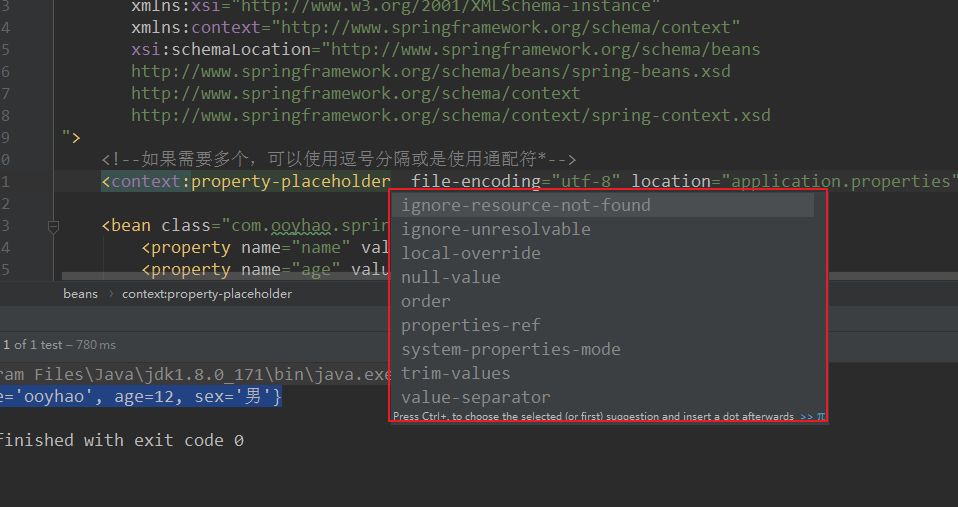
Spring Expression Language
介绍
Spring Expression Language :缩写 SpEL。Spring3引入的,它能够以一种强大和简洁的方式将值装配到Bean属性和构造器参数中,在这个过程中所使用的表达式会在运行时计算得到值。使用SpEL,我们可以实现超乎想象的装配效果,这是使用其他的装配技术难以做到的。
SpEL拥有很多特性,包括:
-
使用bean的ID来引用bean。
-
调用方法和访问对象的属性。
-
对值进行算数、关系和逻辑运算。
-
正则表达式匹配。
-
集合操作。
与属性占位符不同的是,属性占位符使用的是
${}, SpEL的表达式是使用#{}。SpEL 拥有很多特性,例如:调用方法,访问属性,调用构造方法。
小试牛刀
下面的结果是:Hello World!
ExpressionParser parser = new SpelExpressionParser();
Expression expression = parser.parseExpression(" 'Hello World'.concat('!') ");
System.out.println(expression.getValue());
下面的结果是:5
ExpressionParser parser = new SpelExpressionParser();
//调用 byte[] 的 length属性
Expression expression2 = parser.parseExpression(" 'Hello'.bytes.length ");
System.out.println(expression2.getValue());//5
下面的结果:HELLO
ExpressionParser parser = new SpelExpressionParser();
Expression expression3 = parser.parseExpression(" 'hello'.toUpperCase() ");
System.out.println(expression3.getValue());//HELLO
Xml文件配置
<?xml version="1.0" encoding="UTF-8"?>
<beans xmlns="http://www.springframework.org/schema/beans"
xmlns:xsi="http://www.w3.org/2001/XMLSchema-instance"
xsi:schemaLocation="http://www.springframework.org/schema/beans
http://www.springframework.org/schema/beans/spring-beans.xsd">
<bean id="address" class="com.ooyhao.spring.bean.Address">
<property name="id" value="#{T(java.lang.Math).random() *10 }"/>
<property name="name" value="上海"/>
</bean>
<bean class="com.ooyhao.spring.bean.User">
<property name="name" value="ooyhao"/>
<property name="age" value="#{T(java.lang.Math).random() *100 }"/>
<property name="addrName" value="#{address.name}"/>
</bean>
</beans>
Java类注解配置
在属性上使用:
public class SpELConfig {
@Value("#{T(java.lang.Math).random() * 10}")
private Integer id;
@Value("北京")
private String addrName;
@Value("#{address.name}")
private String address;
@Bean
public Address address(){
return new Address(id,addrName);
}
@Bean
public User user(){
return new User("1",23,address);
}
}
在方法上使用 :
@Value("#{address.name}")
public void setAddrName(String addrName) {
this.addrName = addrName;
}
在构造方法上使用:
注意:在构造方法上使用,需要与@Autowired 配合使用,并且如果需要使用,则全部都需要注入,单个注入会报编译错误。
@Component
public class User {
@Value("#{'林黛玉'}")
private String name;
@Value("#{T(java.lang.Math).random() * 4 + 16}")
private Integer age;
private String addrName;
public User() {}
@Autowired
public User(@Value("#{address.name}") String addrName){
this.addrName = addrName;
}
public User(String name, Integer age,String addrName) {
this.name = name;
this.age = age;
this.addrName = addrName;
}
public String getName() {
return name;
}
public void setName(String name) {
this.name = name;
}
public Integer getAge() {
return age;
}
public void setAge(Integer age) {
this.age = age;
}
public String getAddrName() {
return addrName;
}
public void setAddrName(String addrName) {
this.addrName = addrName;
}
@Override
public String toString() {
return "User{" +
"name='" + name + '\'' +
", age=" + age +
", addrName='" + addrName + '\'' +
'}';
}
}
SpEL所支持的参考文档和文档:
https://blog.csdn.net/fanxiaobin577328725/article/details/68942967
支持:(下面仅测试部分类型,具体详细的可以查看Spring官方文档)
字面量
ExpressionParser parser = new SpelExpressionParser();
// Hello World
String helloWorld = (String) parser.parseExpression("'Hello World'").getValue();
// 6.0221415E23
double avogadrosNumber = (Double) parser.parseExpression("6.0221415E+23").getValue();
// 2147483647
int maxValue = (Integer) parser.parseExpression("0x7FFFFFFF").getValue();
// true
boolean trueValue = (Boolean) parser.parseExpression("true").getValue();
// null
Object nullValue = parser.parseExpression("null").getValue();
也可以写作:
@Value(" 'Hello World' ")
private String hello;
@Value("6.0221415E+23")
private Double num;
@Value("0x7FFFFFFF")
private Integer maxValue;
@Value("true")
private Boolean bool;
@Value("null")
private Object oNull;
对象
调用对象,对象的属性,对象的方法。 [?.] 会先判断问号左边是否为空,是则直接注入null,不在调用右边的方法。
@Value("#{user}")
private User user;
@Value("#{user.name}")
private String userName;
@Value("#{user.name.toUpperCase()}")
private String nameUp;
@Value("#{user.getAddrName().toUpperCase()}")
private String addrUp;
@Value("#{user.getName() ?.toUpperCase()}")
private String upName;//null
@Bean
public User user(){
return new User(null,23,"shanghai");
}
类型
@Value("#{T(java.lang.Math).PI}")
private Double pi;// 3.141592653589793
@Value("#{T(java.lang.Math).random() * 100}")
private Integer randomNum;
运算符
| 运算符类型 | 运算符 |
|---|---|
| 算数运算符 | +、-、*、/、%、^ |
| 比较运算符 | <、>、==、<=、>=、lt、gt、eq、le、ge |
| 逻辑运算 | and、or、not、| |
| 条件元素符 | ?:(ternary)、?:(Elvis) |
| 正则表达式 | matches |
集合计算
@Value("#{ user.mobilePhone[1].getName() }")
private String name;// 小米手机
@Value("#{ user.mobilePhone[1].getColors()[0] }")
private String color;//Pink
/*过滤name是华为手机的MobilePhone对象到一个集合*/
@Value("#{ user.mobilePhone.?[name eq '华为手机' ] }")
private List<MobilePhone> mobilePhone;
//[MobilePhone{name='华为手机', colors=[Blue, Yellow, Green]}]
/*投影,将user对象中所有的mobilePhone的name属性投影到一个集合中*/
@Value("#{ user.mobilePhone.![name] }")
private List<String> names;//[华为手机, 小米手机, 小米手机]
/*选择user对象中所有的mobilePhone中第一个name属性为小米手机的MobilePhone*/
@Value("#{ user.mobilePhone.^[name eq '小米手机'] }")
private MobilePhone mobilePhone1;//MobilePhone{name='小米手机', colors=[Pink, Red, White]}
/*选择user对象中所有的mobilePhone中最后一个name属性为小米手机的MobilePhone*/
@Value("#{ user.mobilePhone.$[name eq '小米手机'] }")
private MobilePhone mobilePhone2;//MobilePhone{name='小米手机', colors=[black, cyan, orange]}
@Bean
public MobilePhone huaWei(){
MobilePhone mobilePhone = new MobilePhone();
mobilePhone.setName("华为手机");
List<String> colors = new ArrayList<String>();
colors.add("Blue");
colors.add("Yellow");
colors.add("Green");
mobilePhone.setColors(colors);
return mobilePhone;
}
@Bean
public MobilePhone xiaoMi(){
MobilePhone mobilePhone = new MobilePhone();
mobilePhone.setName("小米手机");
List<String> colors = new ArrayList<String>();
colors.add("Pink");
colors.add("Red");
colors.add("White");
mobilePhone.setColors(colors);
return mobilePhone;
}
@Bean
public MobilePhone xiaoO(){
MobilePhone mobilePhone = new MobilePhone();
mobilePhone.setName("小米手机");
List<String> colors = new ArrayList<String>();
colors.add("black");
colors.add("cyan");
colors.add("orange");
mobilePhone.setColors(colors);
return mobilePhone;
}
总结:
本节基于上节的基础上,进一步了解了Spring的装配特性,从上一节中如何装配Bean到这一节的条件化Bean,歧义性Bean和外部属性值,以及Spring Expression Language 的使用。至此,Spring的IoC部分的大多数知识也已经涉及到,至于高级API知识和源码分析等就不再深入,等本人达到一定水平后,在回头研究Spring或SpringBoot,这一系列主要是基于Spring-in-Action这本书所记录的笔记,系统的复习和再次深入学习一遍。
案例地址:源码地址:
https://gitee.com/ooyhao/JavaRepo_Public/tree/master/Spring-in-Action/spring-in-action-03
最后
如果觉得不错的话,那就关注一下小编哦!一起交流,一起学习






